
A small roller of diameter 20 cm has an axle of diameter 10 cm (see figure below on the left). It is on a horizontal floor and a meter scale is positioned horizontally on its axle with one edge of the scale on top of the axle (see figure on the right). The scale is now pushed slowly on the axle so that it moves without slipping on the axle, and the roller starts rolling without slipping. After the roller has moved 50 cm, the position of the scale will look like this (figures are schematic and not drawn to scale)
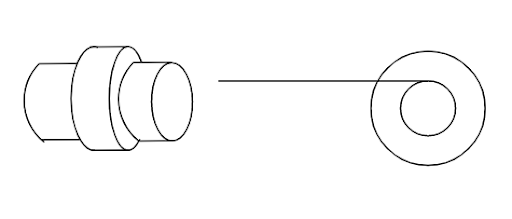
A. 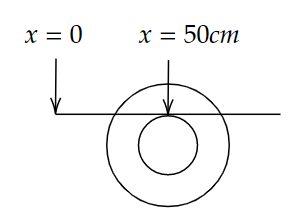
B. 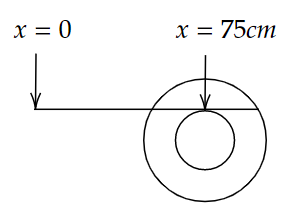
C. 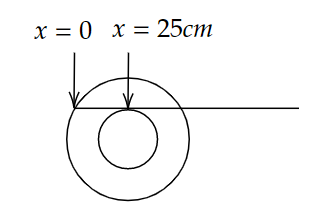
D. 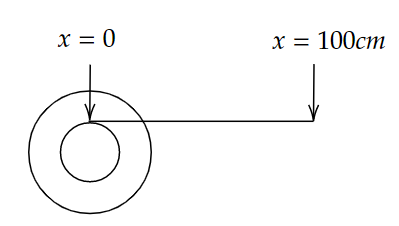
Answer
180k+ views
Hint: Before we start addressing the problem, we need to know about the linear and angular velocity. The velocity at which the body moves in a linear motion is known as linear velocity. The velocity at which the body moves in a rotational motion is known as angular velocity.
Formula Used:
The formula for the relation between linear and angular velocity is,
\[v = r\omega \]
Where, v is linear velocity, r is radius and \[\omega \]is angular velocity.
Complete step by step solution:
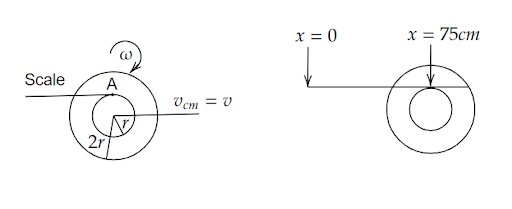
Consider a small roller placed on the horizontal floor of diameter 20 cm has an axle of a diameter of 10cm, a meter scale is positioned horizontally on its axle with one edge of the scale on top of the axle. Now the scale is pushed slowly on the axle so that it moves without slipping on the axle, and the roller starts rolling without slipping. After the roller has moved 50 cm, then we need to find how the position of the scale will look.
So, \[{d_1} = 10cm\], \[{r_1} = 5cm\], \[{d_2} = 20cm\]and \[{r_2} = 10cm\]
Now, \[\dfrac{{{r_1}}}{{{r_2}}} = \dfrac{5}{{10}}\]
\[\dfrac{{{r_1}}}{{{r_2}}} = \dfrac{1}{2}\]
If the ratio of the radius of the axle to the roller is \[\dfrac{1}{2}\] then, the radius of the axle is r and the radius of the roller is 2r. As shown in figure, the velocity at the center is \[{v_{cm}} = v\]it is moving with an angular velocity \[\omega \]without slipping. Then,
\[v = r\omega \]
\[\omega = \dfrac{v}{r}\]
Since, \[r = 2r\](radius of roller)
\[\omega = \dfrac{v}{{2r}}\]
Now, we want to find the velocity at point A. Here, the axle will roll as well as move forward having both translational and rotational velocity that is,
\[v + \dfrac{v}{{2r}} \times r\]
\[ \Rightarrow \dfrac{{3v}}{2}\]
After some time the roller has moved 50 cm on the ground that is, \[v \times t = 50cm\]. Then, the distance will be,
\[ \Rightarrow x = \dfrac{{3\left( {v \times t} \right)}}{2}\]
\[ \Rightarrow x = \dfrac{{3\left( {50} \right)}}{2}\]
\[ \therefore x = 75\,cm\]
Therefore, the position of the scale is 75 cm.
Hence, Option B is the correct answer
Note:Remember that, if a sphere of some radius r is rolling with some speed v, then it has both linear and angular velocity and the relation between these two is given by, \[v = r\omega \].
Formula Used:
The formula for the relation between linear and angular velocity is,
\[v = r\omega \]
Where, v is linear velocity, r is radius and \[\omega \]is angular velocity.
Complete step by step solution:

Consider a small roller placed on the horizontal floor of diameter 20 cm has an axle of a diameter of 10cm, a meter scale is positioned horizontally on its axle with one edge of the scale on top of the axle. Now the scale is pushed slowly on the axle so that it moves without slipping on the axle, and the roller starts rolling without slipping. After the roller has moved 50 cm, then we need to find how the position of the scale will look.
So, \[{d_1} = 10cm\], \[{r_1} = 5cm\], \[{d_2} = 20cm\]and \[{r_2} = 10cm\]
Now, \[\dfrac{{{r_1}}}{{{r_2}}} = \dfrac{5}{{10}}\]
\[\dfrac{{{r_1}}}{{{r_2}}} = \dfrac{1}{2}\]
If the ratio of the radius of the axle to the roller is \[\dfrac{1}{2}\] then, the radius of the axle is r and the radius of the roller is 2r. As shown in figure, the velocity at the center is \[{v_{cm}} = v\]it is moving with an angular velocity \[\omega \]without slipping. Then,
\[v = r\omega \]
\[\omega = \dfrac{v}{r}\]
Since, \[r = 2r\](radius of roller)
\[\omega = \dfrac{v}{{2r}}\]
Now, we want to find the velocity at point A. Here, the axle will roll as well as move forward having both translational and rotational velocity that is,
\[v + \dfrac{v}{{2r}} \times r\]
\[ \Rightarrow \dfrac{{3v}}{2}\]
After some time the roller has moved 50 cm on the ground that is, \[v \times t = 50cm\]. Then, the distance will be,
\[ \Rightarrow x = \dfrac{{3\left( {v \times t} \right)}}{2}\]
\[ \Rightarrow x = \dfrac{{3\left( {50} \right)}}{2}\]
\[ \therefore x = 75\,cm\]
Therefore, the position of the scale is 75 cm.
Hence, Option B is the correct answer
Note:Remember that, if a sphere of some radius r is rolling with some speed v, then it has both linear and angular velocity and the relation between these two is given by, \[v = r\omega \].
Recently Updated Pages
Class 11 JEE Main Physics Mock Test - FREE Online Mock Test Series 2025

Degree of Dissociation Important Concepts and Tips for JEE

Learn Conversion of Galvanometer into Ammeter and Voltmeter for JEE Main

JEE Main Chemistry Question Paper PDF Download with Answer Key

Electric Field Due To Uniformly Charged Ring - JEE Main 2025

JEE Electricity and Magnetism Important Concepts and Tips for Exam Preparation

Trending doubts
JEE Main 2025 Session 2: Application Form (Out), Exam Dates (Released), Eligibility, & More

JEE Main 2025: Derivation of Equation of Trajectory in Physics

Displacement-Time Graph and Velocity-Time Graph for JEE

Atomic Structure - Electrons, Protons, Neutrons and Atomic Models

Learn About Angle Of Deviation In Prism: JEE Main Physics 2025

What is Hybridisation in Chemistry?

Other Pages
NCERT Solutions For Class 11 Physics Chapter 2 Motion In A Straight Line - 2025-26

NCERT Solutions For Class 11 Physics Chapter 1 Units and Measurements - 2025-26

NCERT Solutions For Class 11 Physics Chapter 3 Motion In A Plane - 2025-26

JEE Advanced Marks vs Ranks 2025: Understanding Category-wise Qualifying Marks and Previous Year Cut-offs

Units And Measurements Class 11 Physics Chapter 1 CBSE Notes - 2025-26

Motion in a Straight Line Class 11 Physics Chapter 2 CBSE Notes - 2025-26




